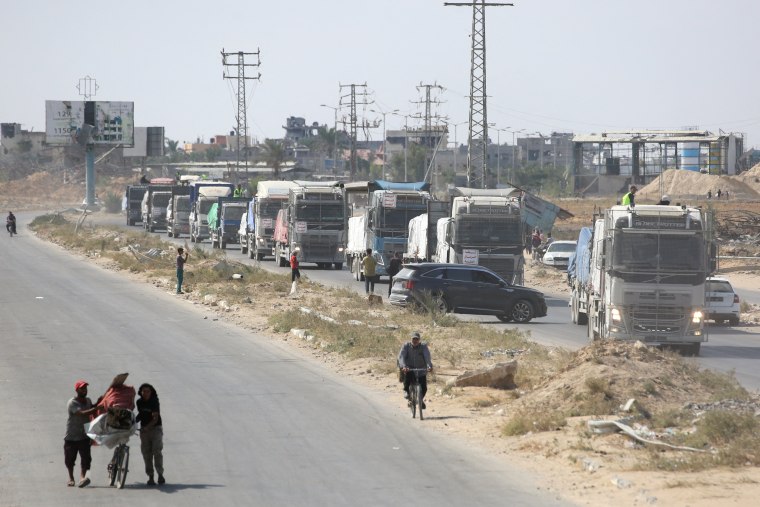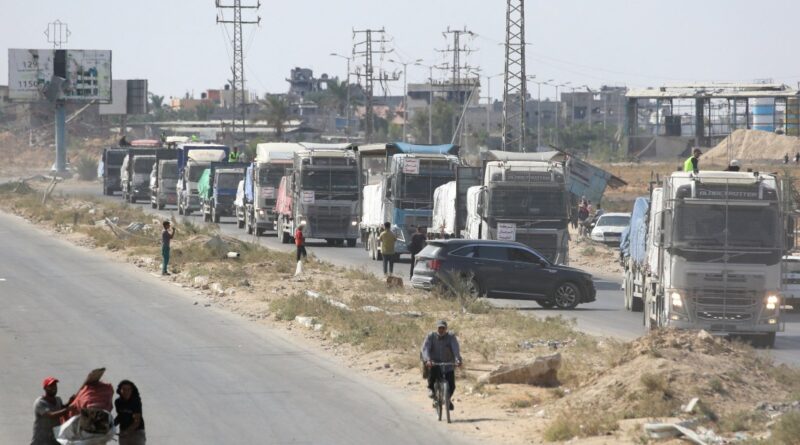Aid trickles into Gaza; Israel receives 10th hostage body
The supply of aid remains critical in Gaza, U.N. agencies have warned, as key border crossings that are vital to getting food into famine-hit areas remain closed.
The World Food Program is supplying approximately 560 tons of food every day, its spokesperson, Abeer Etefa, told reporters on Friday. However, the agency is facing challenges in both ramping up the quantity, as key crossings remain shut, and in its delivery due to destroyed roads.
“It is very important to have these openings in the north,” Jens Larke, spokesperson for the U.N. Office for the Coordination of Humanitarian Affairs, said Friday. “That is where the famine took hold.”
Etefa said there are only two crossings operational, none in the north, where the crisis is the most acute.
“We’re still below what we need. But we’re getting there,” she said. “Roads are blocked and destroyed, which is a huge limitation to transport.”

Israel’s military earlier this week informed the United Nations it would halve the amount of aid expected to enter Gaza due to the slow release of the remains of Israeli hostages, a key point of contention between Hamas and Israel.
Israel says Hamas is delaying the release of the remaining dead hostages inside Gaza, while Hamas says it will take time to search for and recover bodies buried under rubble.
The ministry of health in Gaza said Saturday that it had received the bodies of 15 Palestinians released by Israel, some of which showed signs of beatings and abuse. The IDF has not responded to requests for comment from NBC News on the allegation that returned bodies have shown signs of torture.
Also on Saturday, Israel said it had received the body of a tenth hostage, leaving the bodies of 18 more in the enclave.
The remains were later identified as Eliyahu Margalit, 75, from Nir Oz kibbutz, who was killed in the Oct. 7, 2023 terror attack and his body taken into Gaza, the IDF said in a post on X.
Two years of war have pushed the population of Gaza to the brink of starvation, with the world’s leading authority on hunger declaring a famine in August in part of northern Gaza, including Gaza City. Very few aid trucks were allowed in by Israel, while aid began to pile up outside the crossings.
As of Thursday, Israel had allowed some 950 trucks into Gaza, according to figures Israel supplied to mediators, Stéphane Dujarric, spokesperson for U.N. Secretary-General António Guterres, told reporters Friday.
The WFP also said it was trying to ramp up food production capacity inside Gaza. Over the past two weeks, nine bakeries in Deir al-Balah and Khan Younis have produced a daily average of over 100,000 bread bundles.
But, it said, “The quantity of nutritious food aid entering Gaza is still insufficient to address the severe hunger conditions.”
Tom Fletcher, the U.N.’s Under-Secretary-General for Humanitarian Affairs and Emergency Relief Coordinator, visited bakeries in Gaza on Friday, citing the supply of ingredients and fuel to power bread-making machines as critical factors.
He said in a post on X that work was underway to “quickly rebuild” food production with the aim of opening 30 bakeries and distributing a million meals a day across Gaza.
Even as the ceasefire between Hamas and Israel holds, violence has flared up.
At least 9 people in a bus were killed Friday after being targeted by Israeli forces, the Gaza civil defense said in a statement Saturday.
The IDF said its troops had “opened fire” at the vehicle, which had crossed the “Yellow line.” The IDF had fired “warning shots” initially, but the vehicle continued its approach in a way “that caused an imminent threat,” it said. “The troops opened fire to remove the threat, in accordance with the agreement,” the IDF added.
That line separates the area Israeli forces still occupy from the areas that it has withdrawn from as part of the ceasefire agreement. On Friday, the Israeli Defense Minister said the line would be physically marked and warned that any trespassers would be targeted.





